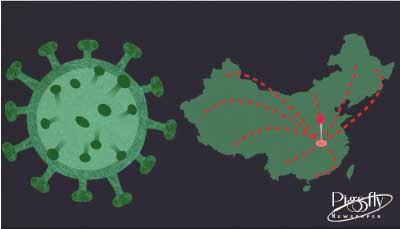Roughly 50 million people are under quarantine in China. Thousands of travelers are being screened at airports every day. Armies of disease detectives are knocking on doors around the world in hopes of halting the new coronavirus in its tracks.
Despite all the colossal efforts to contain the virus, scientists are quietly preparing for a grim — and increasingly likely — outcome: A full-blown global pandemic.
 Bruce Aylward, the WHO expert who has visited Wuhan, speaks to the media about coronavirus Coronavirus latest updates: WHO mission director warns world is ‘simply not ready’
Bruce Aylward, the WHO expert who has visited Wuhan, speaks to the media about coronavirus Coronavirus latest updates: WHO mission director warns world is ‘simply not ready’
Since the novel virus was isolated in December in the Chinese megacity of Wuhan, the pathogen has reached four continents and infected more than 24,000 people. At least 493 of them have died as a result. With the outbreak continuing to expand, authorities acknowledge that efforts will soon shift from trying to squelch the coronavirus to learning to live with it.
“We’re proceeding as if things go really sour on us in the coming weeks and months,” said Dr. Anthony Fauci, director of the National Institute of Allergy and Infectious Diseases at the National Institutes of Health. “We’re working for the worst-case scenario.”
Beware of coronavirus outbreaks coming back to life, WHO warns
- Scientists still to determine the intermediate host of the disease, raising risk of recurrence
- Study by Hong Kong and mainland China researchers finds that more than half of the patients did not have a fever when admitted to hospital
Health experts have highlighted challenges with the coronavirus epidemic, with the WHO warning of the risk of outbreaks coming back to life and researchers in mainland China and Hong Kong pointing out a major difficulty with diagnosis.
The alerts came on Friday as the World Health Organisation declared that the risk of global spread of the coronavirus epidemic had become “very high” – though the UN health agency stopped short of calling it a pandemic.
In a joint study published in the New England Journal of Medicine, researchers from mainland China and Hong Kong reviewed the cases of 1,099 coronavirus patients from 552 hospitals in 30 provinces.
They found that more than half the patients did not have a fever when they went into hospital, making diagnosis more difficult. But 88.7 per cent of them did develop one after admission.
“Some patients with Covid-19 do not have fever or radiologic abnormalities on initial presentation, which has complicated the diagnosis,” the study said, referring to the disease caused by the coronavirus.
The study was co-authored by dozens of medical experts, including Zhong Nanshan, director of China’s State Key Laboratory of Respiratory Diseases, and Chinese University of Hong Kong respiratory medicine expert Professor David Hui Shu-cheong.
So far, the epidemic has killed 2,835 people on the mainland, with 47 more fatalities on Saturday. Mainland China has 79,251 infections, with 39,002 patients recovered. Source SCMP: https://www.scmp.com/news/china/science/article/3053033/beware-coronavirus-outbreaks-coming-back-life-who-warns
Professor Kanta Subbaraco Director of WHO explains coronavirus
Corona-virus Live update Source China’s NHC
Global Cases by Johns Hopkins CSSE
Corona-virus COVID-19 Global Cases by Johns Hopkins CSSE
Corona-virus COVID-19 Live Situation Global Cases by World Health Organisation “WHO”
Support Pigsfly Newspaper
Corona virus
WHAT IS IT?
Coronaviruses are a family of viruses found in animals that cause respiratory illnesses like colds, flu and pneumonia. When a new strain jumps to humans, often through the handling and slaughter of wild animals, it can be dangerous as we have little immunity against it. This new strain is about 75 per cent similar to the SARS virus that emerged in 2002, but while it is spreading fast it so far appears to have a lower mortality rate.
HOW IS IT SPREAD?
People can catch the virus from handling wild animals, touching contaminated surfaces or close contact with infected people. According to NSW Health, it can spread during as little as 15 minutes of face-to-face conversation or two hours in an enclosed space with an infected person. People can be infectious during the 1-14 day incubation window, before symptoms appear. Another factor complicating prevention is the suggestion that the new coronavirus, unlike Sars, is transmissible even by people who are not showing any symptoms. At a press conference on Sunday, China’s National Health Commission said the virus, unlike its predecessor, was contagious even during the incubation period which lasts up to 14 days.
IS THERE A VACCINE? NO
World Health Organisation “WHO” says a coronavirus vaccine is 18 months away
China has released the genome of the virus to help speed up the global race for a vaccine. In Australia, the CSIRO hopes to start testing vaccines within six weeks and a San Diego lab in the US is using a new DNA technology for its own trials.
CASES ON THE RISE WHAT IS THIS DOING TO AIR TRAVEL?
Direct flights from Wuhan to Australia ended on January 23 as the city went into lockdown but, despite demands by the transport union, Australia is not suspending flights from China, as countries such as Italy have done.

The case described — from Germany — could help resolve one of the major unknowns about the virus, which as of Thursday night had infected nearly 9,700 people in China and killed 213. About 100 more infections have been reported in 18 other countries, but no deaths.
Some viruses, including SARS, which is another coronavirus, can only be passed when a person is showing symptoms. Others, like the flu, can be spread a day or two before the onset of symptoms. If people are contagious before they become sick, they can be unknowingly spreading the virus as they go shopping or to work or to the movies. Trying to snuff out the virus in that case is a much more difficult task.
What’s also concerning is that the spread from an asymptomatic person appeared to lead to two generations of cases, meaning the person who contracted the virus then passed it on to others.

As the 2019 novel coronavirus outbreak continues to spread in China, researchers have found that people carrying the virus but not showing symptoms may be able to infect others.
If infected people can spread 2019-nCoV while asymptomatic, it could be harder to trace contacts and contain the epidemic, which is already a global health emergency (SN: 1/30/20).
An unnamed Shanghai woman passed the virus to business colleagues in Germany before she showed signs of the illness, doctors report January 30 in the New England Journal of Medicine. The woman had attended a business meeting at the headquarters of the auto supplier Webasto in Stockdorf on January 20 and flew back to China on January 22. She became ill with mild symptoms on the flight back to China and tested positive for the virus.
Meanwhile, one of her German colleagues fell ill on January 24 with a fever, sore throat, chills and muscle aches. His illness was brief, and he returned to work on January 27, the same day that the woman informed the company she carried the virus. Nasal swabs and sputum, or phlegm, samples from the man contained high levels of the novel coronavirus even though his symptoms had passed.
These Are the Symptoms of Coronavirus
As the deadly coronavirus 2019-nCoV spreads throughout the world, doctors are getting a better understanding of what symptoms and warning signs to keep an eye out for.
Some extreme cases involve patients coughing up blood or going into septic shock, Foreign Policy reports. More typically, however, symptoms remain milder — potentially letting some cases slip under the radar and worsening the outbreak.
Like other coronaviruses, 2019-nCoV can cause pneumonia and other respiratory and cardiovascular conditions: coughing, fever, fatigue, and soreness. Because the outbreak is in the middle of flu season, FP reports, that can make distinguishing between the two difficult.
As the disease progresses, it can cause more severe symptoms including difficulty breathing, kidney injury, and heart damage.
The virus is most dangerous for the elderly or people who are already sick — the mortality rate is substantially higher within those particular groups than the general population, according to FP.
Screening for new cases is also difficult because 2019-nCoV patients can spread the disease while they remain asymptomatic for as long as two weeks — compared to most viral infections which cause symptoms within the first few days.
History and Recent Advances in Coronavirus Discovery
Human coronaviruses, first characterized in the 1960s, are responsible for a substantial proportion of upper respiratory tract infections in children. Since 2003, at least 5 new human coronaviruses have been identified, including the severe acute respiratory syndrome coronavirus, which caused significant morbidity and mortality. NL63, representing a group of newly identified group I coronaviruses that includes NL and the New Haven coronavirus, has been identified worldwide. These viruses are associated with both upper and lower respiratory tract disease and are likely common human pathogens. The global distribution of a newly identified group II coronavirus, HKU1, has not yet been established. Coronavirology has advanced significantly in the past few years. The SARS epidemic put the animal coronaviruses in the spotlight. The background and history relative to this important and expanding research area are reviewed here.
Satire cuts through
China announcement
the Ministry of Health and Community Protection announced the detection of a new case of coronavirus for people from one family from Wuhan, People’s Republic of China.
In its statement, the Ministry of Health and Community Protection added that the health of the injured is stable and under medical observation.
The Ministry confirmed that, in coordination with health authorities and the concerned authorities in the country, it has taken the necessary precautions necessary in accordance with the scientific recommendations, conditions and standards approved by the World Health Organization and that the general health situation is not a cause for concern.
The Ministry stressed that the epidemiological investigation centers in the country are working around the clock to early report any cases of the virus .. stressing that the health system in the country works very efficiently and that the ministry is closely following the situation in a way that guarantees the health and safety of everyone.
What is novel coronavirus?
Coronaviruses are a large family of viruses. They cause illnesses that can range from the common cold to more severe diseases. Severe diseases have included:
Health authorities have identified new coronavirus cases in China in early January 2020. We are learning much more about it.
However, we still don’t know enough about:
- how it transmits
- clinical features of the disease
- how it spreads
- the source of infection
Health authorities have identified new coronavirus cases in:
- mainland China
- Hong Kong
- Macau
- Taiwan
- Japan
- Thailand
- Malaysia
- South Korea
- Vietnam
- Singapore
- Nepal
- France
- Australia
- USA
- Canada
- Cambodia
- Germany
- Sri Lanka
- United Arab Emirates
- Finland
- India
- the Philippines
- England
- Italy
Symptoms of novel coronavirus
The virus can cause a range of symptoms. Symptoms can range from mild illness to pneumonia. Affected people may experience:
- fever
- flu like symptoms such as coughing, sore throat and headaches
- difficulty breathing
How you can help prevent novel coronavirus
Everyone should practise hygiene and other measures to protect against infections.
These measures include:
- washing your hands
- covering your mouth while coughing or sneezing
- avoiding contact with wild or farm animals
Diagnosis
A person is classified as a suspected case if they meet certain criteria.
After being assessed by a health professional, a suspected case will be tested for the virus. They might also order a chest x-ray.
What to do if you become unwell
If you become unwell and suspect you may have symptoms of coronavirus, you must seek medical attention.
Please ring ahead of time to book your appointment. This will help make your doctor aware of your symptoms and your travel history.
Call 000 if you need urgent medical help.
How is novel coronavirus treated?
Specialist infectious diseases teams will isolate people with symptoms of coronavirus. They will provide supportive medical care to treat any symptoms.
I’m travelling to China, what is the risk of catching novel coronavirus?
International travellers to China should check the latest Department of Foreign Affairs and Trade (DFAT) travel advice on the Smartraveller website.
Most people with confirmed novel coronavirus worked at or visited a seafood and live animal market in Wuhan. Authorities close this market from 1 January 2020.
Chinese health authorities have now implemented monitoring, control and prevention measures including contact tracing and isolation of cases. Authorities are also closing and sterilising other wet markets in the area.
If you are travelling:
- avoid contact with sick people
- regularly wash your hands
- avoid touching your face and mouth after touching surfaces
These practices are especially important if you have contacted animals.
As a precaution, you should avoid visiting wet markets in general, but particularly in Wuhan.
Health authorities both in Australia and globally are closely monitoring the virus as the situation develops.
What is Australia doing about novel coronavirus?
The Department of Health is monitoring the situation. We are ready to increase our response activities if and when we need to.
Australia has well-established procedures to ensure people with illnesses travelling into the country are detected at the border.
Australia already requires passengers who show signs of an infectious disease, including fever, sweats or chills, to report their illness to aircrew. Biosecurity officers then meet the sick travellers when they arrive in Australia so they can assess them.
We work closely with State and Territory Chief Health Officers, to ensure we coordinate an evidence based response in Australia.
Health is also discussing novel coronavirus with the Department of Agriculture. Agriculture manages Australia’s biosecurity at the border, including:
- human health
- the World Health Organization
- our international counterparts




























